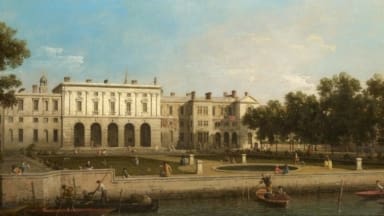
Thousands of gardens have vanished across London over the past five hundred years, ranging from princely pleasure grounds and private botanical gardens, to humble allotments and defunct squares, artists’ gardens, eccentric private menageries and the ecological parks of the twentieth century. Lost Gardens of London will explore this legacy and reveal tantalising glimpses of some of the rich and varied gardens that once embellished the metropolis.
The exhibition’s guest curator, landscape architect and historian Dr Todd Longstaffe-Gowan, has assembled a wide range of unfamiliar illustrative material, including paintings, prints, drawings, photographs and maps, to bring these lost gardens to life. The gardens depict changing trends and fashions in gardening while exploring London’s enduring love affair with nature, demonstrating how green spaces have always been a vital part of life in the capital.
In every borough, parks, gardens and green open spaces have succumbed to new roads, street-widenings, railway encroachments and new buildings, or have simply been swallowed up by suburbia. Accompanying public programmes will explore how the remaining green spaces that may be taken for granted in London today have survived thanks to protests, community action and legal protections being put in place. The exhibition is a timely reminder of the vulnerability of urban gardens and access to nature.
Highlights of the exhibition will include Old Somerset House from the River Thames by Giovanni Canaletto (c.1750), which the Venetian artist painted during his long sojourn in England. The painting shows an idyllic view of Old Somerset House looking out over its large public garden which was described as having an ‘Air of Grandeur suitable to a Royal Palace ‘. The building is now home to the Courtauld Gallery, and a road cuts across the site of the garden.
The Antwerp-born painter Jan Siberechts’s View of a House and its Estate in Belsize, Middlesex (1696) on loan from Tate, portrays one of the oldest gardens included in the exhibition. Belsize was at the time was a distant country retreat for affluent Londoners. Green stretches as far as the eye can see, with Westminster Abbey far on the horizon. Today this area is part of north-west London, and the green expanse connecting central and north boroughs has been largely swallowed up by the city.
An illustration from 1874 by F Shepherd depicts a “lion’s den” in Earl’s Court created by surgeon and anatomist Dr John Hunter, while illustrations from the London Metropolitan Archives will explore the history of Surrey Zoological Gardens, which occupied about fifteen acres adjacent to Kennington Park Road and was one of the earliest examples of a public garden created to display ‘real animated nature’ (wild birds and animals) in their ‘natural condition’ – or what they believed in the early nineteenth century to be naturalistic settings.
The present site of Waterloo Station was formerly occupied an early independent botanic garden. Here William Curtis, one of the capital’s most celebrated botanists, cultivated thousands of plant species, specialising in native British flora. The central London setting is unrecognisable in a watercolour view of c.1787 depicting the garden by botanical illustrator James Sowerby. The only clue to the garden’s proximity to London is St Paul’s Cathedral visible on the horizon. Also featured in the exhibition is an early volume of Curtis’s Flora Londinensis (1777) recording the metropolitan flora, and possibly the first publication to be devoted to urban nature.
In more recent times, William Curtis was celebrated again at the William Curtis Ecological Park adjacent to Tower Bridge. This ephemeral garden is portrayed in photographs by Jon May. Created in 1977 on an old lorry park, the two-acre site was transformed into a mosaic of habitats including woodland, flower-rich grassland and a pond. During its short life it had over 100,000 visits from local schoolchildren who participated in butterfly identification and frog-catching. The park provided a link with the natural world that was rare inner-city children, until it closed in 1985 to make way for new developments and is now the site of the Mayor’s Office.
“Our fascination with lost gardens is often fuelled by our interest in reconstructing worlds that supply us with a powerful means of making sense of the past,” said the exhibition’s curator, Longstaffe-Gowan.
Garden Museum Director Christopher Woodward says: “This exhibition celebrates London’s gardens through the eyes of Dr Todd Longstaffe-Gowan, who has devoted over thirty years to exploring the contributions that gardens and gardeners have made to the metropolis. It also aims to remind people just how fragile London’s green spaces are in the face of development, neglect and pollution. As recently as six years ago in 2018, a small park St James’s Garden in Camden vanished to make way for HS2.”
The Lost Gardens of London exhibition will take place at the Garden Museum, from the 23rd of October 2024 until the 2nd of March 2025.

